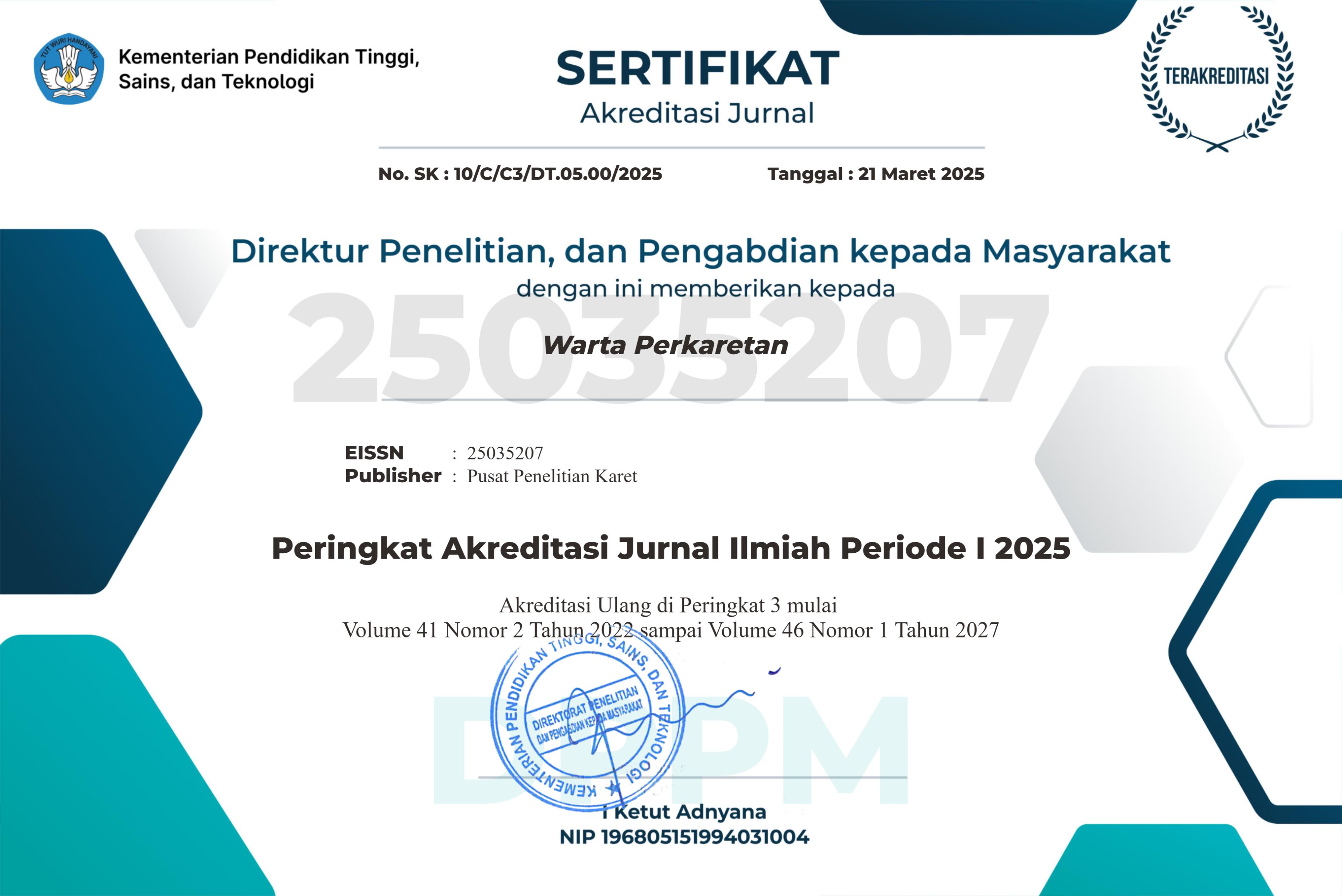POLA PRODUKSI DAN INDEKS LUAS DAUN PADA TANAMAN KARET YANG TERSERANG Pestalotiopsis
DOI:
https://doi.org/10.22302/ppk.wp.v40i2.842Keywords:
BPM 24, gugur daun, keparahan penyakit, PB 260Abstract
Secaraalami,tanamankaretmenggugurkandaunsebagairesponskekeringan untuk mengantisipasi defisit air tanah pada proses transpirasi. Pengurangan jumlah daun pada tanaman karet tidak hanya terjadi akibat periode gugur daun saja, namun adanyakejadianpenyakitdaunsepertipenyakit gugur daun Pestalotiopsis juga dapat mengakibatkan tanaman melakukan gugur daun. Gugur daun dan pembentukan daun baru akan berpengaruh terhadap nilai indeks luas daun dan produksi lateks. Penelitian dilakukandiKebunPercobaanPusatPenelitian Karet Sembawa, Sumatra Selatan, pada klon PB 260 tahun tanam 2005 dan BPM 24 tahun tanam 2004 untuk mengetahui pola produksi dan nilai indeks luas daun yang terserang penyakit gugur daun Pestalotiopsis. Pengamatan yang dilakukan meliputi produksi lateks selama satu tahun, serta pengukuran indeks luas daun dan keparahan penyakit setiapbulanselamasatutahun.Hasilpenelitianmenunjukkanpenurunannilaiindeks luas daun tidak berpengaruh secara langsung terhadap penurunan produksi lateks, namunpadasaattanamanmelakukanpembentukandaunbaru(nilaiLAImeningkat),produksilateksmengalamipenurunanyangsignifikan.Selainitu,peningkatan keparahan penyakit gugur daun Pestalotiopsis memiliki hubungan yang cukup kuat dengan penurunan indeks luas daun tanaman. Pada saat keparahan penyakit tinggi dan terjadi gugur daun, indeks luas daun menurun hingga mencapai 0,5.
References
Ardika, R., Cahyo, A. N., & Wijaya, T. (2011). Dinamika gugur daun dan produksi berbagai klon karet kaitannya dengan kandungan air tanah Indonesian. Jurnal Penelitian Karet, 29(2), 102-109.
Cahyo, A.N., Sahuri, Stevanus, C.T., Aji, M. (2017). Production of PB 260 rubber clone in relation with field water balance. In Jacob, K. et al. (Ed.), Proceedings of International Rubber Conference 2017. Indonesian Rubber Research Institute and International Rubber Research and Development Board.
De Bei, R., Fuentes, S., Gilliham, M., Tyerman, S., Edwards, E., Bianchini, N., Smith, J., & Collins, C. (2016). VitiCanopy: a free computer app to estimate canopy vigor and porosity for grapevine. Sensors, 16, 585. doi: 10.3390/s16040585
Fang, H., & Liang, S. (2014). Leaf area index models. In Reference Module in Earth Systems and Environmental Sciences. Elsevier, Amsterdam.
Febbiyanti, T. R., & Fairuza, Z. (2019). Identifikasi penyebab kejadian luar biasa penyakit gugur daun karet di Indonesia. Jurnal Penelitian Karet, 37(2), 193-206. doi: 10.22302/ppk.jpk.v37i2.616.
Furtado, E. L., Moraes, W. B., Junior, W. C. J., Anjos, B. B., & Silva, L. G. (2020). Epidemiology and management of South American leaf blight on rubber in Brazil. In: H. K. Baimey et al. (Ed.), Horticultural Crops. London, UK : IntechOpen Ltd.
Guyot, J., Cilas, C., & Sache, I. (2008). InfIuence of host resistance and phenology on South American Leaf Blight of the rubber tree with special consideration of temporal dynamics. European Journal Plant Pathology, 120(2). doi: 111-124 10.1007/s10658-007-9197-6
Hincapié, J. J. G., Gaona, O. J. C., Restrepo, J. P. R., García, D. A. M., Arredondo, J. D. H., & Bustamante, E. G. M. (2020). Phenological patterns of defoliation and refoliation processes of rubber tree clones in the Colombian northwest. Rev. Fac. Nac. Agron. Medellín, 73(3). doi: 10.15446/rfnam.v73n3.80546
Kinhal, V. (2020, Oktober 14). The importance of leaf area index (LAI) in environmental and crop research. CID Bio-Science. Diakses di www.cid-inc.com.
Krishnan, A., Joseph, L., & Roy, C. B. (2019). An insight into Hevea-Phytophthora interaction: The story of Hevea defense and Phytophthora counter defense mediated through molecular signalling. Current Plant Biology, 17, 33-41. doi: 0.1016/j.cpb. 2018.11.009.
Kusdiana, A. P. J., Syafaah, A., & Febbiyanti, T. R. (2017). Resistance of rubber clones recommended in Indonesia to Corynespora and Colletotrichum leaf fall diseases. In Jacob, K. et al. (Ed.), Proceedings of International Rubber Conference 2017. Indonesian Rubber Research Institute and International Rubber Research and Development Board.
Kusdiana, A. P. J., Sinaga, M. S., & Tondok, E. T. (2020). Diagnosis penyebab penyakit baru gugur daun karet (Hevea brasilinesis Muell. Arg.). Jurnal Penelitian Karet, 38(2), 165-178. doi: https://doi.org/10.22302/ppk.jpk.v35i2.374
Kusdiana, A. P. J., Sinaga, M. S., & Tondok, E. T. (2021). Pengaruh klon karet terhadap epidemi penyakit gugur daun Pestalotiopsis. Warta Perkaretan, 40(1). doi:https://doi.org/10.22302/ppk.wp.v40i1.747
Liyanage, K. K., Khan, S., Mortimer, P. E., Hyde, K. D., Xu, J., Brooks, S., & Ming, Z. (2016). Powdery mildew disease of rubber tree. Forest Pathology, 46(2), 90–103. doi: 10.1111/efp.12271.
Oktavia, F., & Lasminingsih, M. (2010). Pengaruh kondisi daun tanaman karet terhadap keragaman hasil sadap beberapa klon seri IRR. Jurnal Penelitian Karet, 28(2): 32-40.
Pawirosoemardjo, S. (2004). Manajemen pengendalian penyakit penting dalam upaya mengamankan target produksi karet nasional tahun 2020. In: Situmorang, A. et al. (Ed.). Prosiding Pertemuan Teknis. Pusat Penelitian Karet.
Pereira, J. P., Leal, A. C., & Ramos, A. L. M. (2018). Evaluation of rubber tree clones under different tapping systems in Northwestern Paraná State, Brazil. Agriculture, Agribusiness and Biotechnology, 61. doi: https://doi.org/10.1590/1678-4324-2018160232
Righi, C. A., Bernardes, M. S., Castro, D.S., & Abbud, D. M. (2001) Fenologia e variação temporal do índice de área foliar de três cultivares de seringueira (Hevea spp.). Agrotrópica, 13(3), 125-132
Simbo, D. J., Van Den Bilcke, N., & Samson, R. (2013). Contribution of corticular photosynthesis to bud development in African baobab (Adansonia digitata L.) and Castor bean (Ricinus communis L.) seedlings. Environmental and Experimental Botany, 95, 1-5. doi: 10.1016/j.envexpbot.2013.07.002
Sinaga, M. S. (2006). Dasar-dasar ilmu penyakit tumbuhan. Jakarta, Indonesia: Penebar Swadaya
Downloads
Published
How to Cite
Issue
Section
License
Copyright (c) 2021 Martini Aji, Alchemi Putri Juliantika Kusdiana

This work is licensed under a Creative Commons Attribution-NonCommercial-ShareAlike 4.0 International License.
Submission of a original research or review articles in Warta Perkaretan implies that the submitted  manuscript has not been published in any scientific journal (except being part of the abstract, thesis, or report). The submitted manuscript also is not under consideration for publication elsewhere. All co-authors involve in the publication of the manuscript should give their approval. Once, the manuscript is accepted and then published in Warta Perkaretan, the Author(s) keep hold the copyright and retain publishing right without restrictions. Author(s) and Warta Perkaretan users are allowed to multiply the published manuscript as long as not for commercial purposes. The journal users are also permissible to share the published manuscript with an acknowledgement to the Author(s). The Editorial Boards suggest that the Authors should manage patent before publishing their new inventions.







